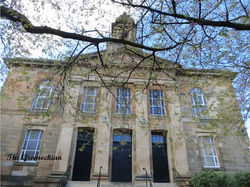History Of Our Church

Special thanks to the The Greenockain for allowing us to use this content.
For more history on Inverclyde please click the link - The Greenockain Facebook Page.
In 2023 we celebrated 200 Years of the Church!

In June 1694 John Corse, Dean of Guild, Glasgow and John Anderson of Dowhill attended the Presbytery of Paisley to obtain authorisation for the Presbytery of Glasgow to supply the people of Port Glasgow with “preaching by some qualified young man … from time to time”, because Port Glasgow being a great distance from the parish church of Kilmacolm and the road being in a bad state of repair, many did not attend any form of worship and spent their Sundays in “idleness and debauchery”! It was decided that the Presbyteries would try to resolve the matter.
It was arranged that George Lyon and six other feuers in Port Glasgow would guarantee the sum of fifty pounds as a yearly stipend for a minister as well as providing him with a house. They also agreed that the money acquired by putting seats in a meeting house to use as a church, and renting them would pay part of the minister’s stipend.
In June 1696 the Commission for the Plantation of kirks granted permission for the building of a church at Newport Glasgow with the following conditions. The magistrates and town council (of Glasgow) would provide the minister and pay his stipend and that the parish of Kilmacolm would not have to pay anything towards the provision of a minister or any of his successors. The Commissioners for the Plantation of Kirks disjoined the parish of New Port Glasgow from Kilmacolm on 1 July 1696. Next the magistrates and town council of Glasgow called upon the minister at Killellan, James Hutcheson along with several members of the council to “do all other things needful and convenient anent the settling and establishing of an eldership and minister in the parish of Port Glasgow”.
The feuers intimated their wish to call the Reverend Robert Millar as their minister. He was ordained minister of Port Glasgow in 1697. Many from Glasgow attended the ordination service. Worship services were held in the “meeting house” (also described as a sail loft) in the town and the Minister was provided with a dwelling paid for by the feuers of the town. In 1709 the Presbytery of Paisley intimated that Robert Miller would be moving to the Abbey Church in Paisley.
It took some time to fill the vacancy at Port Glasgow, but eventually the magistrates and town council presented Thomas Davidson to be minister in the town. However the Earl of Glencairn who was patron for the church at Kilmacolm opposed Glasgow’s choice of minister and insisted that he should have a say in who was appointed. It was argued that Port Glasgow had been disjointed from Kilmacolm, but the matter dragged on, the Glasgow officials unwilling to enter into and expensive law suit with Glencairn. Negotiations took place at Findlayston between Glencairn and representatives of Glasgow. Glencairn eventually agreed that the matter should be decided by arbitration. Time dragged on and eventually after the payment of a fee, Glencairn renounced any interest in deciding who should be minister in Port Glasgow.
The Reverend John Anderson was then nominated as minister for Port Glasgow and it was agreed that a church should be built in the town. Francis Stevenson, wright was appointed to go to Port Glasgow and inspect the ground where the church would be built, meet with the feuers and agree to the conditions for the building of a church. The feuers would provide half of the expense of the building with the town of Glasgow paying the other half. James Baird, mason of Govan was to be the architect and John Hunter, mason in Port Glasgow was to be the builder. The church was cruciform in shape.
Kirk Wall
Provision was also made for a church yard around the church which was to be subdivided into burial places which could be bought by feuers in the town. Two of the feuers John Lyon and James Cooper would be responsible for the building of “a regular stone dyke three ells high from the foundation” enclosing the kirkyard. It would have “pillars at every eight foot distance and put a bosom stone in the middle betwixt each pillar for distinguishing the burial places … which are to consist of eight foot in breadth and twelve foot in length”. The prices for the burial lairs were to cover the construction of the kirkyard. A loft, opposite the pulpit was to be built and furnished with seats for the magistrates and inhabitants of Glasgow, this extra expense to be met by the magistrates and town council of Glasgow. Another loft was built for use by the feuers of Port Glasgow.
Church Foundations
The original church building was demolished in 1823 because a new, larger building was required for the growing town. There was one big problem - the new church was to be rectangular in shape and would take up some of the churchyard that had been used as burial places. The problem was overcome by building the new church on plinths so as not to disturb the graves below. There are still graves under the present day building.
 |  |  |
|---|---|---|
 |  |  |
 |  |  |
 |  |  |
 |
